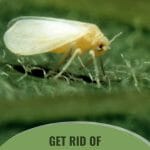
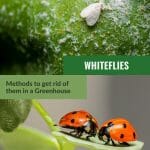

It’s remarkable how something so small as a whitefly can cause so much damage to greenhouse plants. If you’ve ever dealt with an infestation of whiteflies, you probably know this firsthand. Whiteflies can be an incredible pain for greenhouse growers due to their long lifecycles and ability to reproduce quickly.
Fortunately, there are several ways to get rid of whiteflies in a greenhouse. Effective methods for whitefly control include using a handheld vacuum, applying insecticidal soaps, or releasing beneficial insects. Ultimately, however, understanding whiteflies and their lifecycle is the key to getting rid of them.
With persistence, creativity, and knowledge about how whiteflies behave, you can eliminate these pests from your greenhouse before they cause too much damage to your plants. In this article, we’ll walk you through what to look for so you can get rid of whiteflies in your greenhouse, and even prevent them from ever returning!
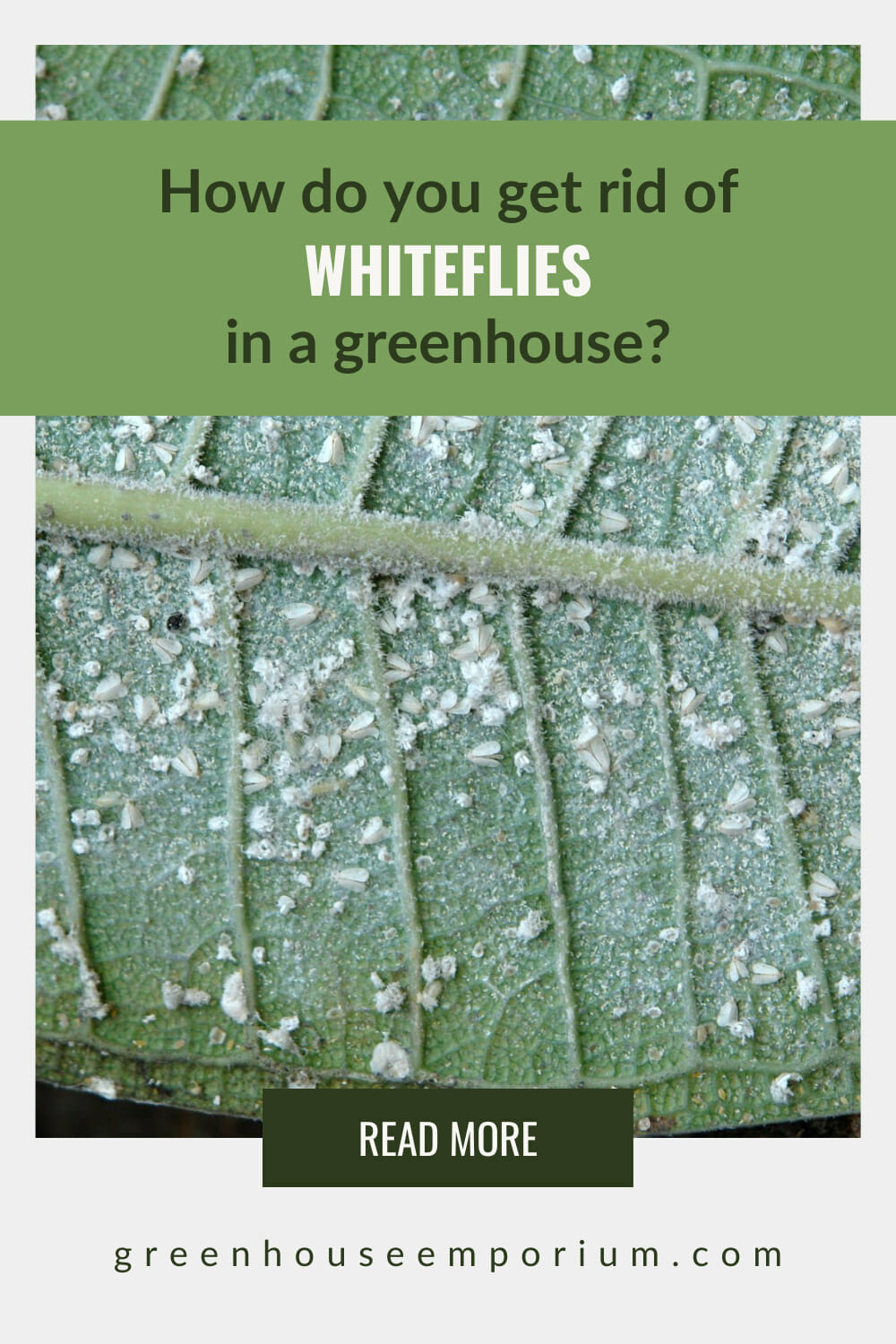
What are whiteflies?
Contrary to their name, whiteflies (order Hemiptera) are not related to true flies (order Diptera). While they do fly, they’re actually more related to aphids and mealybugs. Like their similarly annoying cousins, whiteflies are sap-sucking insects that suck plant juices and nutrients from the leaves.
Whiteflies get their name from the white-colored wax coating on their wings. Often, whiteflies are yellow, white, or cream in color, and certain species will even have colored markings.
The life cycle of whiteflies
Adult whiteflies can produce 200-400 eggs, so it’s an understatement to say they reproduce very quickly. Once these eggs hatch, a whitefly has four nymphal stages (also referred to as instars).
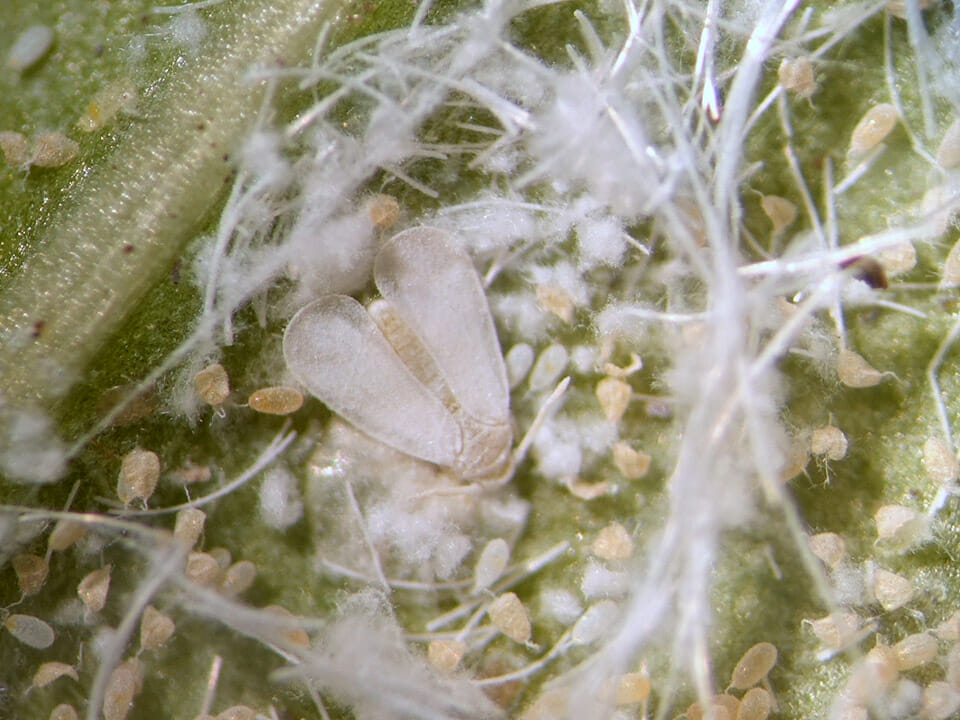
The first stage is often called the crawling stage, where they crawl away from the egg location. Then they enter the feeding stage, where they flatten into an oval-like shape to the leaf and feed. The later nymphal stages can be hard to distinguish, but the total period generally lasts about 2-4 weeks.
Whitefly nymphs can range in colors from yellow to black and are very difficult to see with the naked eye. At this stage, they can look quite similar to scale insects and are very difficult to spot since some whiteflies will change color to blend into the leaf.
Adults eventually emerge from the later nymph stages. Whitefly adults can go on to live for a couple of months. Even as adults, whiteflies are tiny, often around 1/12th of an inch in length.
At all stages, from nymph to adult, whiteflies feed by sucking out a plant’s nutrients, excreting honeydew as a byproduct.
Whiteflies in a greenhouse
Whiteflies are naturally drawn to warmer environments. In USDA Zones 7 and colder, they won’t survive outdoors during the winter, but in warmer locations, they can survive just fine all year round.
Unfortunately, greenhouses are an ideal environment for whiteflies, especially greenhouses that are temperature-controlled during the winter.
The most common way whiteflies infiltrate a greenhouse is by hitching a ride on seedlings from other greenhouses, nurseries, or gardens. They can also get into your greenhouse during the summer months through open windows or doors.
How do you know if you have whiteflies in your greenhouse?
Whiteflies prefer to feast on new plant growth since it’s the most tender and nutritious, so you’re likely to find them clustered on and around newer leaves. Start by looking for the most obvious sign of whiteflies: tiny bugs flying away when you shake the leaves.
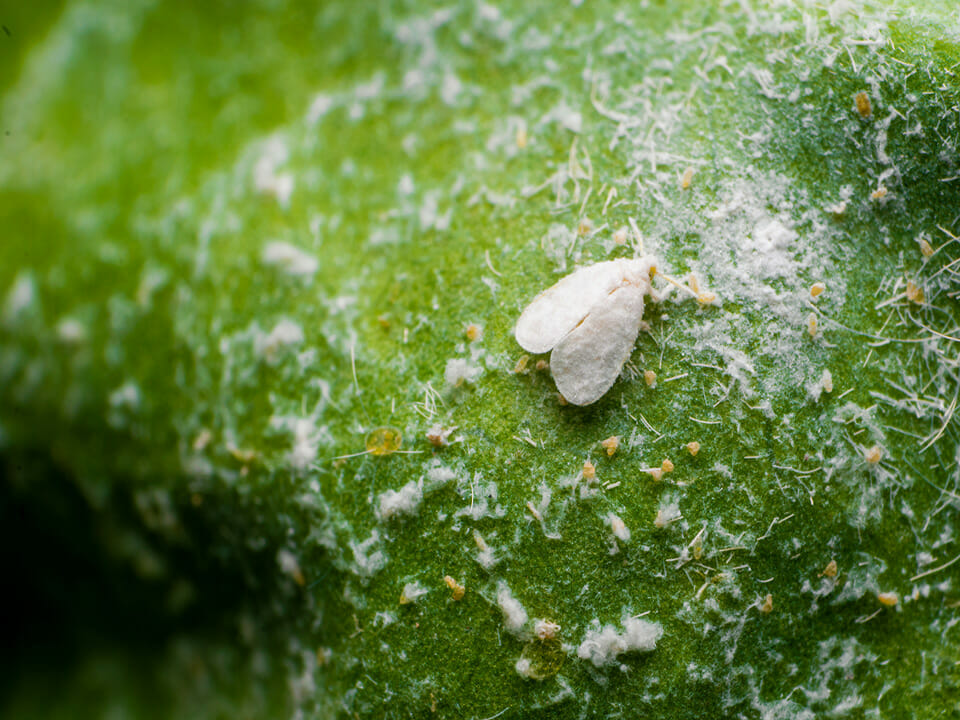
Next, check for eggs and nymphs on the undersides of leaves. That’s where adult whiteflies hide and lay more eggs. Although whitefly eggs are tiny, you might recognize them by the circular pattern in which they’re laid.
You may also notice signs of your plant declining with no obvious explanation. For example, new growth might emerge deformed, or leaves appear yellowed and sickly.
Another sign of a whitefly infestation is if the leaves are sticky (honeydew). While on its own, honeydew won’t harm your plants, it can lead to fungal diseases, including sooty mold.
How much damage can whiteflies do to your greenhouse plants?
Whiteflies behave very similarly to aphids, using their mouthparts to puncture plant tissue and suck out the plant’s juices. A single whitefly won’t cause significant damage, but an infestation can reduce photosynthesis and cause your plant’s health to decline. Leaves turn yellow and eventually die off, and, in severe cases, the plant itself can die.
In addition, the lesions caused by whiteflies biting into the tissue can leave the plant vulnerable to bacteria and fungal diseases. Plus, the honeydew that they excrete can further invite fungal diseases, which can cause major harm to your plant. Honeydew also attracts ants, which in turn protect the whiteflies to secure a steady supply of the sweet substance.
Types of whiteflies you can commonly find in greenhouses
There are over a thousand known whitefly species, but many prefer only one type of plant as their host. A handful of whitefly species are much less picky and will feed on a wide range of host plants, and these are the ones you’re most likely to find in your greenhouse:
| Species | Appearance | Host preference |
| Ash whitefly (Siphoninus phillyreae) | Nymphs have very distinct fringes around their bodies. | Broadleaf trees, citrus, flowering fruit trees. |
| Greenhouse whitefly (Trialeurodes vaporariorum) | Nymphs have longer, hair-like fringes. | Very broad range of hosts, from vegetables to ornamental plants. |
| Bandedwinged whitefly (Trialeurodes abutiloneus) | Adult bodies are more gray with light brown stripes. Nymphs have short, waxy filaments. | Cotton, petunias, ragweed, poinsettias and even some vegetables. |
| Iris whitefly (Aleyrodes spiraeoides) | Adults have a single dot on each wing. | Landscape plants and potatoes. |
| Citrus whitefly (Dialeurodes citri) | Nymphs have no edges but do have a prominent “Y” shape in the middle of their backs. | Citrus, ficus, pomegranate. |
| Sweet potato whitefly (Bemisia Tabaci biotype A) | Nymphs have no fridges or filaments. Adult wings are tilted slightly downward. | Both herbaceous and woody-type plants. |
| Silverleaf whitefly (Bemisia tabaci biotype B) | Adults are smaller, and more yellow than most whitefly species. | Broad variety of plants, but particularly broccoli, squash, melons, cabbage and ornamental plants. |
| Giant whitefly (Aleurodicus dugesii) | Mottled, gray wings | Begonia, hibiscus, banana plants, bird of paradise and most vegetables. |
7 organic pest control methods to get rid of whiteflies in a greenhouse
Regardless of which whitefly species has infiltrated your greenhouse plants, you can get rid of them with the same organic methods. Try using a combination of the methods below for best results.
1. Spray down your plant
You can remove most adult whiteflies and even some nymphs by taking a hose and thoroughly spraying down your plant. This method is very effective as long as the affected plants are isolated from the rest of your greenhouse (i.e. taking the potted infected plant outside). Otherwise, the whiteflies may simply be able to fly to a new host.
2. Hand-held vacuum
Running a vacuum over your plant’s leaves and stems is a highly effective way to get rid of whiteflies in your greenhouse. You should do this as gently as possible, so the leaves don’t get ripped off the plant. It’s also essential that you don’t empty the vacuum bag inside the greenhouse and accidentally re-release the pests.
3. Horticultural oils
Horticultural oils such as neem oil are a great way to get rid of whitefly nymphs and eggs. When applied correctly, the oil will smother the whitefly eggs and larvae.
Make sure to apply horticultural oils in a diluted spray on the leaves and do so only in the evening. Oils can cause the leaves to become hypersensitive to UV rays, and the leaves may burn if exposed to sunlight.
4. Soap
There are some organic insecticidal soaps on the market that will kill whitefly adults, nymphs, and even eggs. The trouble is, you’ll have to read the label carefully, particularly if the affected plant is one that you are growing for consumption.
All-natural dish soap can be gentler for your plants, but deadly to whiteflies and other pests. Washing your plant’s leaves with a mild dish soap can also eliminate those whiteflies for good.
5. Garlic spray
Like many pests, whiteflies don’t like the strong smell of garlic, so crushing a few garlic bulbs and mixing them with water will make a very effective spray for your plants that is more natural than chemicals.

The downside to using garlic spray is that the odor can quickly fill up your greenhouse, so if you’re averse to this particular scent, you may want to skip this treatment option.
6. Yellow sticky traps
Whiteflies are drawn to the color yellow because, to them, it resembles new foliage growth. You can purchase yellow sticky traps to catch any adult whiteflies or use yellow index cards with petroleum jelly as an alternative.
7. Beneficial insects
If you’re open to introducing beneficial insects to your greenhouse, several varieties will prey upon your whiteflies. Lacewings, minute pirate bugs, and even ladybugs will feast on those whiteflies without causing your plants any harm.
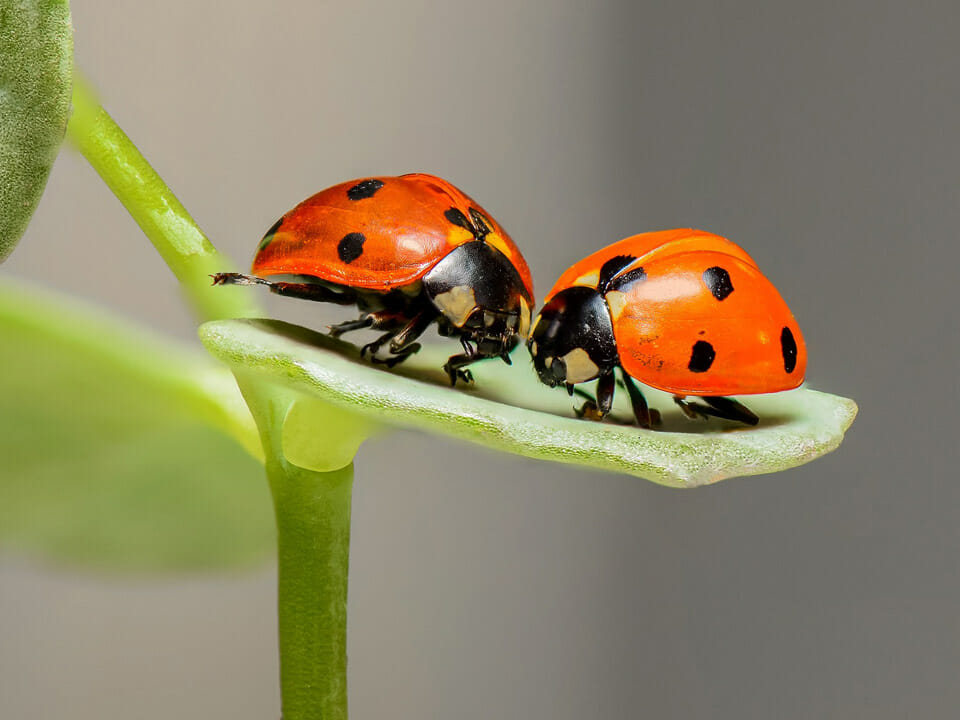
If you release beneficial bugs into your greenhouse, don’t use the other methods listed, as they can harm the beneficial insects, as well as the pests.
Can you remove honeydew from your plants?
If your tomato plant leaves have honeydew residue from whiteflies, they’re at risk of developing sooty mold, which can spread quickly to the rest of your plant’s leaves. If the leaf already has sooty mold, you can gently wipe the leaf down with a cloth, or prune and discard the leaf altogether.
You can also remove honeydew from the leaves with neem oil treatments. Fortunately, neem oil is also a great natural fungicide.
How to prevent whiteflies in your greenhouse
In many ways, preventing whiteflies in your greenhouse can be easier than getting rid of them once you have them. Having a solid pest prevention routine in place will not only prevent whiteflies from getting out of control but other pests too.
Here are a few ways that you can prevent future infestations of whiteflies in your greenhouse:
- Keep your greenhouse tidy and free from debris to reduce the risk of infestations and diseases. You can learn more about keeping your greenhouse clean here.
- Reflective mulch, such as aluminum, is a great way to confuse whiteflies and keep them away from your plants
- Thoroughly inspect new plants and seedlings before you bring them into your greenhouse. If possible, quarantine them for a few weeks before bringing them closer to your other plants.
- Use any of the above organic treatments to treat your plants preventatively, even if there are no visible signs of a whitefly infestation.

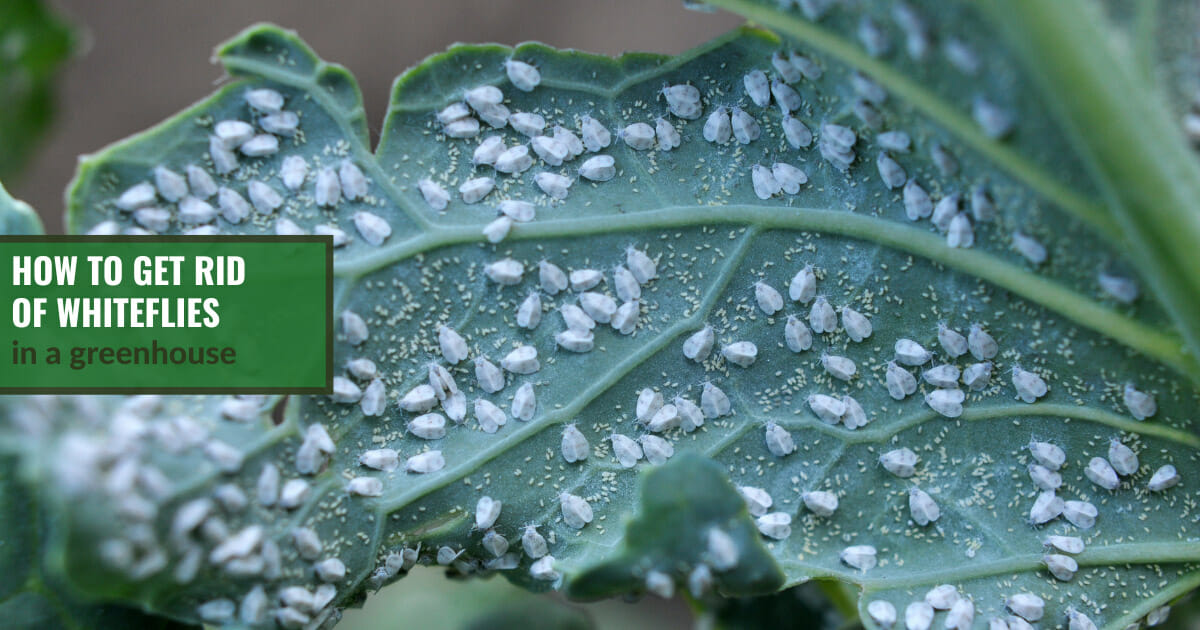































2 comments
I had a whitefly infestation this past summer and tried all the above with a fine conical spray so as the get the top and bottom of all leaves. The only thing I did not try was foil Mulch. I did knock a dent in their population a little at a time but I still killed some today on my beets, peppers and cilantro. So, I still have them.
Hi Wayne! Thanks for sharing your experience. It must be aggravating that nothing got fully rid of your whitefly problem. I’ve seen a lot of people had issues with massive whitefly infestations last summer. Keep using neem oil until you don’t see them anymore and then still spray every 2 weeks. I hope you’ll get your greenhouse whitefly-free this year.